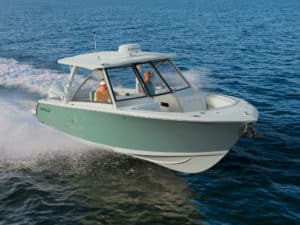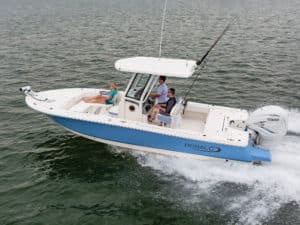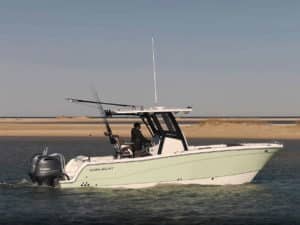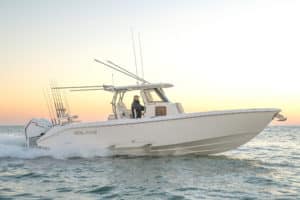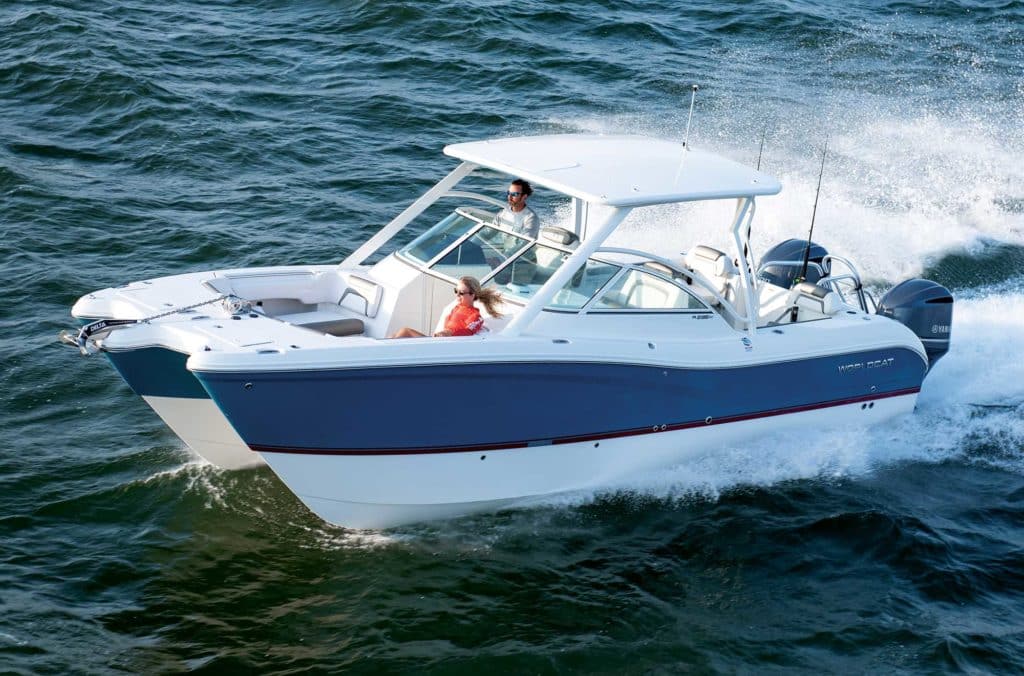
Being a hardcore fisherman is all well and good, an admirable pursuit. But angling habits often evolve through life’s seasons. Thirtysomething anglers with children, for instance, find their interests can sometimes take a back seat to family outings that focus on picnics and watersports.
Boatbuilders know that. For all those purposes, they have developed fishable dual-console boats, equipped with creature comforts such as bow lounging, berths, galleys, and heads with showers. World Cat goes one step further with its 296DC, introducing a state-of-the-art dual console built on a stable catamaran platform with remarkable standard fishing features.
Seasoned anglers know that cat boats perform well in rough water — conditions that can hamper family fun. Cats also prove stable when the seas threaten to rock.
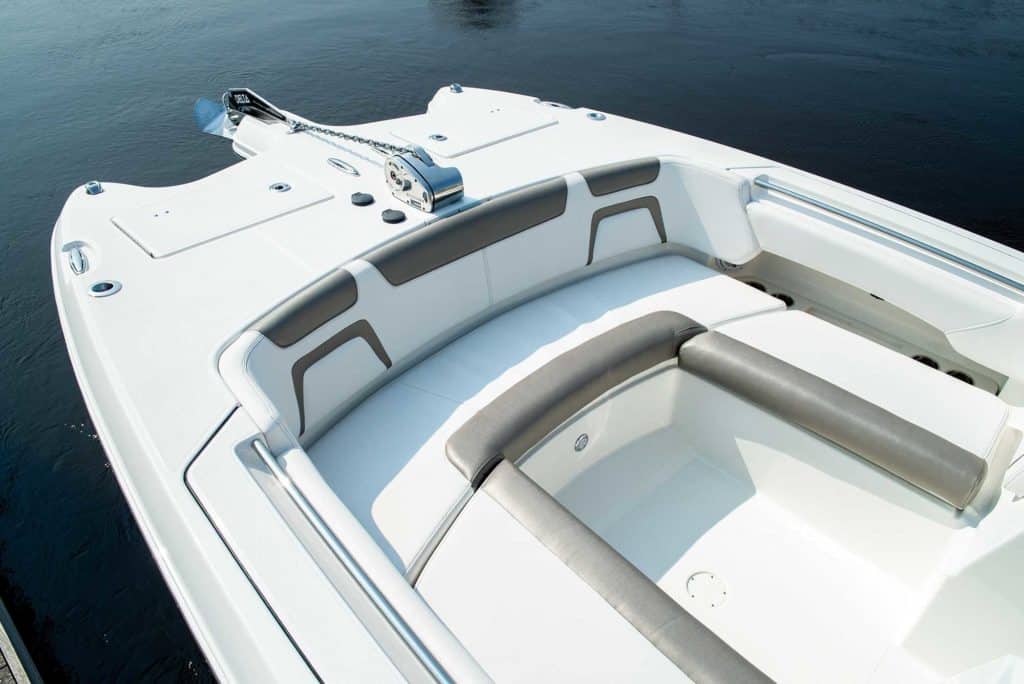
Built to Bounce
And it was just those bumpy seas that greeted me and a crew from World Cat for our Fish Trial off Charleston this past August. Contrary to typical summer doldrums, we experienced a stiff wind out of the southeast as we left port with rods stowed in five of the six gunwale holders, several of which double as cup holders.
We hoped to catch-and-release bull redfish at some fish-holding structure and shoals nearshore. Our captain, Wilson Hanna from RedFin Charters, had his proven spots dialed in, but due to the timing of my trip, the tide was not ideal.
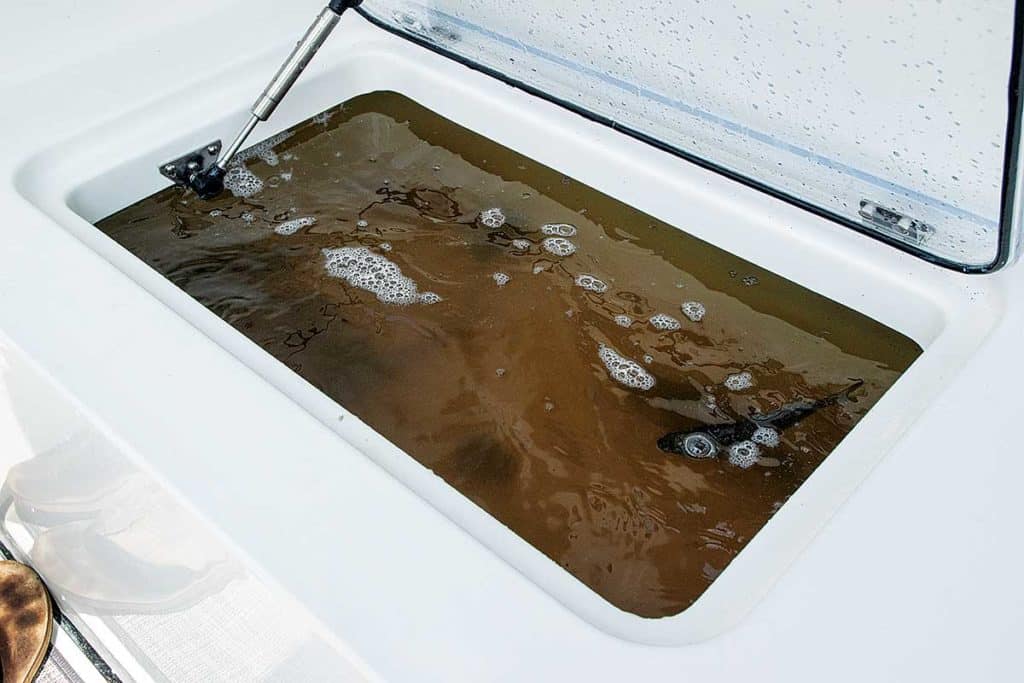
Mid-harbor, we idled to take on some live mullet from a buddy of Hanna’s. Wyatt Lane, World Cat’s national distribution manager, opened the acrylic lid and readied the 25‑gallon insulated livewell beneath the port aft‑facing seat box.
We rounded the harbor jetty heading south into a 2- to 4-foot close chop. “This is the right boat to be in today,” I suggested to Lane and Alex Flora, World Cat’s associate marketing manager.
Lane lowered the throttles, and the twin Yamaha F300s sped us across the wave tops. After a brief, dry run, we idled in about 17 feet of water. When Hanna gave the signal, Lane pressed the standard windlass’s rocker switch.
As we settled on anchor, I commented to Lane that this cat boat’s “sneeze” seemed impressively subdued. Because of the space between the two sponsons of a catamaran, at certain headings, compressed air throws a fine mist of spray out the bow. Lane explained that the new 296DC has a flatter tunnel than many other catamaran hulls to minimize this.
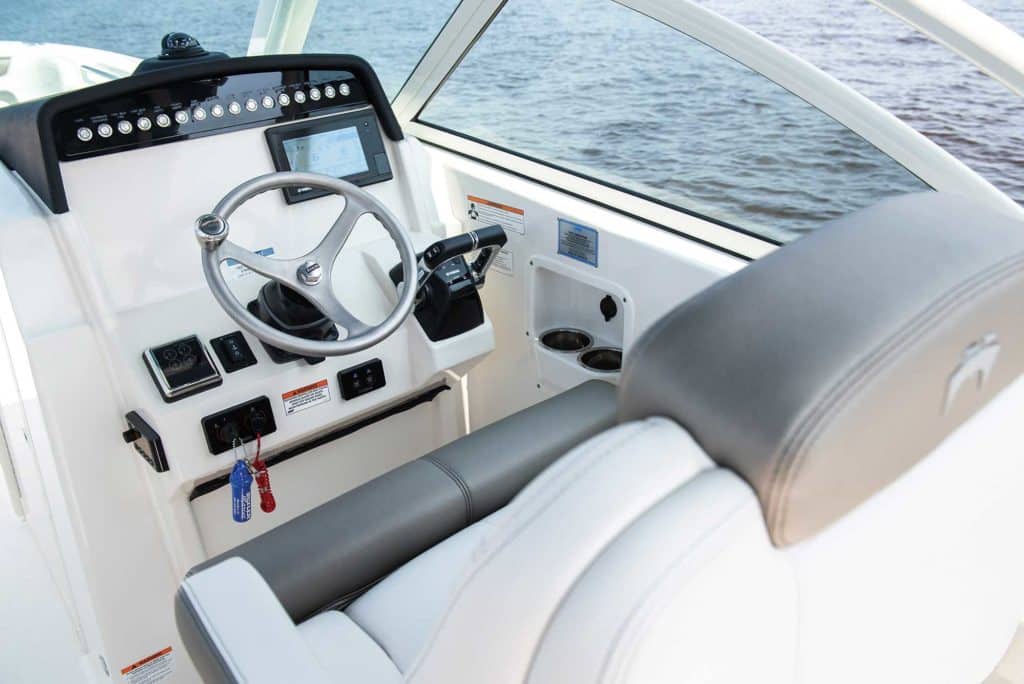
Added Innovation
In fact, the 296DC features the same hull as World Cat’s 295DC, and its sister ship, the center-console 295CC, which debuted in 2015. But the 296 brings some design changes topside, including a new lower-profile hardtop and frame, updated helm and passenger seats, lower aft-facing seat boxes, the seat-box livewell, a 37½-gallon fish box beneath the starboard seat box, an updated dash and switch panel, standard Yamaha CL7 gauge, and more.
Hanna dip-netted mullet from the livewell and pinned them to the circle hooks that tipped the weighted leaders on five different Daiwa outfits. He cast them in all directions, and set them into transom and gunwale holders. We watched rod tips expectantly.
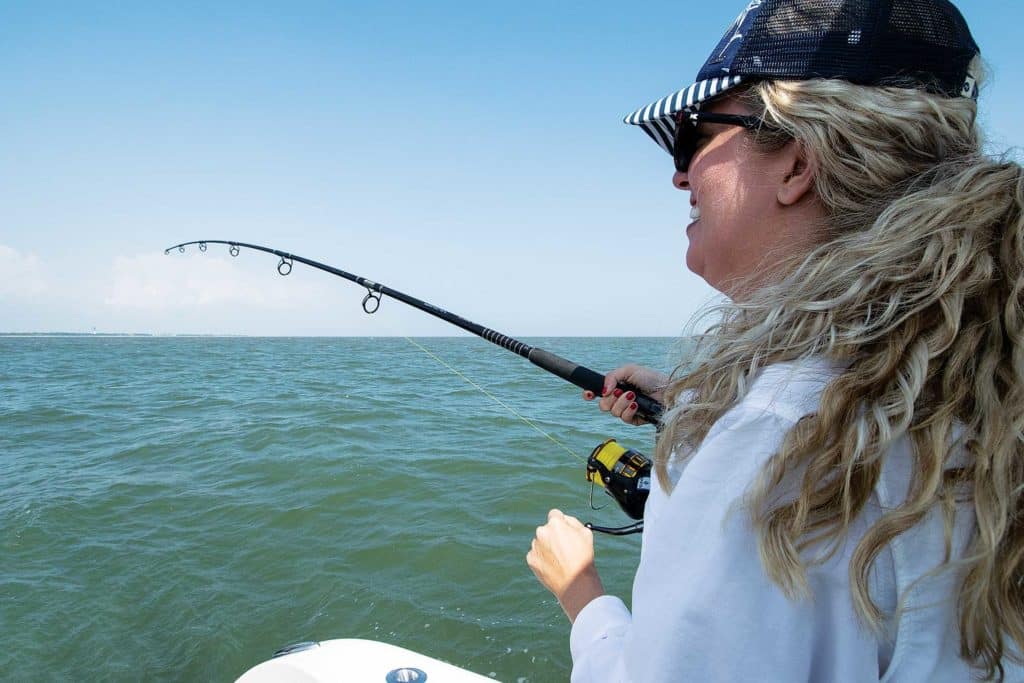
When bull reds hit, the rod arcs like a sapling in squall winds. The port corner rod dipped, and Hanna quickly handed it to Flora. The fish took line as she steadied the pressure, moving along the coaming that rims the sizable, 513-square-foot cockpit.
Cat boats carry their full beam from stern to bow, creating more deck space than deep-V’s with comparable lengths. The 296DC cockpit also measures 25 inches deep in the aft corners, a safety factor for younger anglers.
As the rest of us readied the deck during the action, I did notice that I had to steer clear of the aft edge of the 100-by-100-inch hardtop. The top offers tremendous shade, but like the full-beam structure of this dual-console design, it can challenge anglers. Such are the trade-offs for comfort.
The fish dogged near the bottom like a dead weight after making several strong runs, signs that Flora’s quarry might sport “wings” rather than traditional fins. Indeed, it finally showed at the surface — a formidable Southern stingray. Hanna clipped the line just above the hook, and the brown bomber floated away.
Multiuse Features
Lane retrieved the anchor, and we tried the first of two additional spots. I opened the windshield and moved through a bifold door to the plush bow for the ride.
As I relaxed on the well-padded benches with their built-in backrests and side bolsters, I found two bow rod holders and plenty of space to throw a cast net. Lane told me that all the holders, and indeed all the hatches — including a forward insulated 56-gallon fish box — that are above the waterline drain overboard, not to the bilge. The hatch lids are all gasketed and finished top and bottom.
Bow passengers can also access multiple cup holders and enjoy a separate audio zone fed by the standard JL Audio system. An optional bow table makes this space a perfect spot for dining or playing games.
The two consoles aboard the 296DC feature a head and changing space to port that offers 6 feet 6 inches of vertical clearance. Anglers can also access lockable horizontal rod storage through a forward door inside the port console. The rods lie in racks that stretch forward, hidden beneath the port bow bench. The starboard console houses an ample stowage locker.
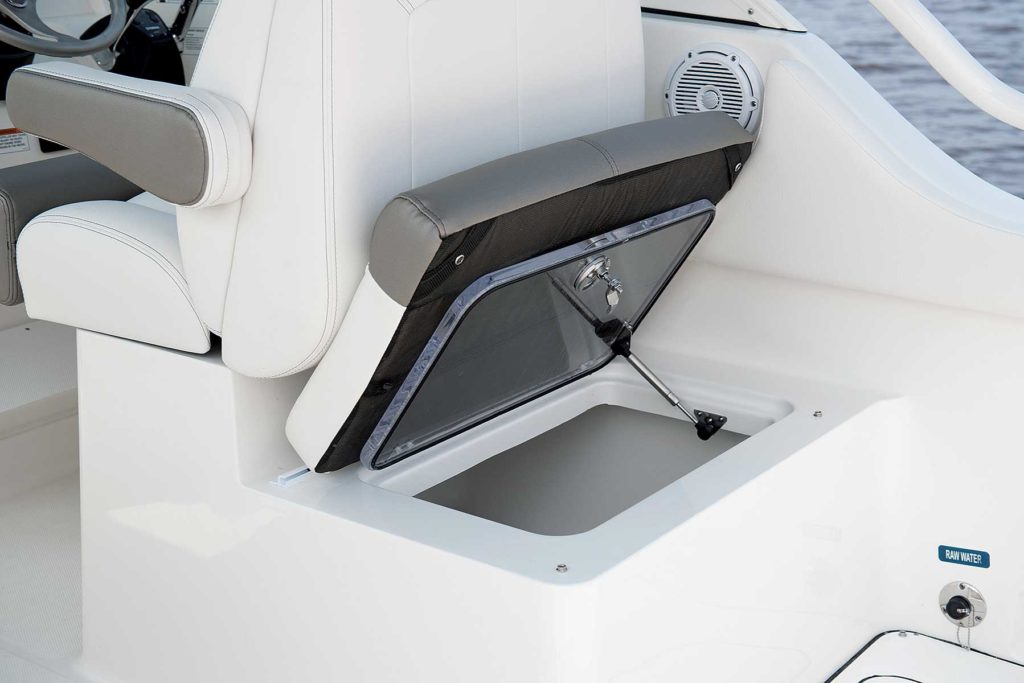
The Llebroc helm seat and passenger seat feature leaning bolsters, armrests, and built-in aft-facing backrests for the cockpit seat boxes. The helm face is wide enough to fit a single 12-inch electronics display and the Yamaha CL7 gauge; World Cat offers a 12-inch Garmin as an option.
My test boat also came with the optional, woven sea-grass-matt flooring, which I’d generally remove for fishing. The cockpit, lined with horizontal rod storage, terminates at a bulkhead that sports twin fold-up jump seats and a transom door. The door opens to a swim platform and dive ladder with full handrails, and a freshwater shower. Anglers will also find bait-prep and tool-storage areas.
Both Worlds
Despite our best efforts, we found no bull red bite. On the way back to port, I took the helm and ran easily along the beam sea. Running into the seas and quartering them, I could not induce a harsh entry.
Handling the 296DC proved seamless: The cat comes standard with power-assisted hydraulic steering, though electronic power steering and SeaStar Systems Optimus 360 joystick steering can be added as options.
The test boat climbed on plane quickly and reached 30 mph in 8.5 seconds. At cruise, the 296DC naturally rides a little bow high and slightly leans out in turns. Inside the harbor, the 296DC sped to a top end of 53.8 mph, turning 5,800 rpm, and achieving 1 mpg. We found our most efficient cruise at 35 mph, turning 3,900 rpm, and tapping 1.5 mpg.
Lackluster bite notwithstanding, the 296DC proved that fishing can coexist with comfort. Hardcore angling no longer translates to Spartan austerity. And that’s a good thing.

